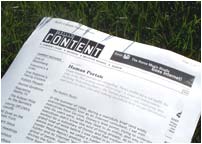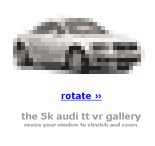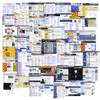
There is a good intro the world of web logs in May’s issue of Brill’s Content called Human Portals. Matt Haughey of MetaFilter graces the cover. I suggest you print it off and read it on the lawn like I did (sunny day recommended).
Web Development
Tim Berners-Lee’s Semantic Web
If you are interested in the future of the web and computing in general, read The Semantic Web in the May issue of Scientific American. Co-authored by Tim Berners-Lee, inventor of the web, the article explores the possibilities of having a machine-readable web, rather than a web intended only for human readers. The automation possibilities are fascinating.
The article also touches on some interesting characteristics of the current web. In particular that while the decentralization of the control on the web brought us the dreaded 404 error, it also allowed for the exponential growth. Berners-Lee is an academic and an idealist (I think you have to be an idealist to use a NeXT computer). He intended [em] tags to encode meaning, emphasis, not [i] tags to slant text. The Semantic Web looks to correct that very problem.
the 5k audi tt vr gallery
The5k is a web competition in which the entries must be less than 5 kilobytes (5,120 bytes) in total file size. To put that in perspective, the front page of actsofvolition.com today is 28 kilobytes of text/HTML and over 41 kilobytes of images. From the5k.org:
PURPOSE
The idea behind the contest is that the rigid constraints of designing for the web are what force us to get truly creative. Between servers and bandwidth, clients and users, HTML and the DOM, browsers and platforms, our conscience and our ego, we’re left in a very small space to find highly optimal solutions. Since the space we have to explore is so small, we have to look harder, get more creative; and that’s what makes it all interesting. Just celebrating that is all.
Some of last years entries were truly amazing including a store with a working shopping cart, a working 3D Tetris game, a drawing program with save funtion, and a web-safe color chart complete with preview, each less than 5 kilobytes.
I made a humble entry last year which was cruelly and viciously mocked (particularly bothersome since the criticisms were witty and somewhat justified).
 My goal this year was to create an entry that would not solicit public ridicule. Together with Nick and Nathan from silverorange, we have created the 5k audi tt vr gallery. Due to obvious file size constraints it only has three frames of rotation. If we had more time, I’m sure we could have squeezed in eight frames and made it more netscape-friendly. However, we only started the day before the deadline (a technique I picked up in my days as an academic).
My goal this year was to create an entry that would not solicit public ridicule. Together with Nick and Nathan from silverorange, we have created the 5k audi tt vr gallery. Due to obvious file size constraints it only has three frames of rotation. If we had more time, I’m sure we could have squeezed in eight frames and made it more netscape-friendly. However, we only started the day before the deadline (a technique I picked up in my days as an academic).
aov does xml
First, let us get some acronym* definitions out of the way:
- aov – acts of volition
- XML – Extensible Markup Language
- RDF – Resource Description Framework
- RSS – RDF Site Summary
With that out of the way, aov has setup an RSS channel. RSS is an XML application based on the World Wide Web Consortium’s RDF Specification.
Now in english: RSS is a simple format for web syndication that lets any site make it’s headlines available to be grabbed by any other compliant site. For example, My.Netscape.com let’s you add these channels as custom news on your home page. Headlines from any site that that creates an RSS channel can be added to your my.netscape.com home page.
![]() The people at My.Netscape.com seem to expect those with an RSS channel to include this graphic on their site. Clicking on this graphic will add aov headlines to your My.Netscape.com page. That is if you can bear the buggy and irritating signup process. Seems more like viral marketing for Netscape than an open news standard. The graphic will not be displayed on aov permanently (only in this post).
The people at My.Netscape.com seem to expect those with an RSS channel to include this graphic on their site. Clicking on this graphic will add aov headlines to your My.Netscape.com page. That is if you can bear the buggy and irritating signup process. Seems more like viral marketing for Netscape than an open news standard. The graphic will not be displayed on aov permanently (only in this post).
The format is cool though. An example of a good implementation can be found at Peter Rukavina’s Reinvented.net (which has been nicely redesigned). The News page at Reinvented.net uses RSS to grab headlines from Slashdot.org, The PEI Government website, and (drumroll please) Acts of Volition.
* acronyms are stupid.
popularity continues to eludes me even into adulthood

I’m not sure what this means but I’m sure you can deduce something from it. Here is a top-down view of the 50 most visited websites on the web.